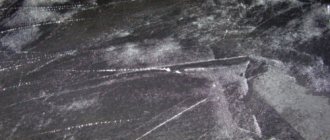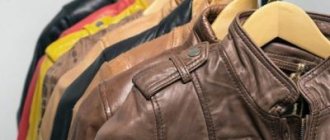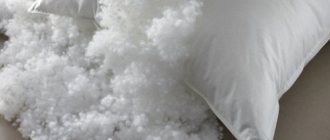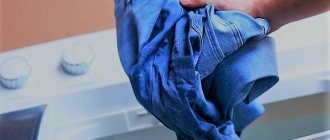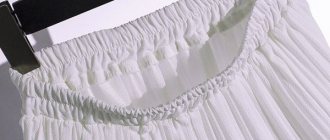How to wash a leather jacket at home? Can I use a washing machine for this? These are the questions asked by fans of outerwear made from natural materials. In our article we will tell you whether it is possible to wash a leather jacket and how to do it correctly.
Dry cleaning for leather clothing is preferable to wet cleaning (washing). Leather jackets protect well from bad weather and serve their owners for a long time. Find out how to care for your skin in this article.
Machine washing rules
To minimize possible harm to the product, follow the instructions below. But first, remove all items from your pockets and remove fur and other decorative elements if they can be removed.
Selecting a remedy
It is better to wash a leather jacket in a washing machine with special gels or similar products. Do not use washing powders: they may leave stains on the product, which you will have to get rid of later.
It is better to choose a liquid detergent that is suitable for gentle washing of items of the corresponding color. Do not use bleaches or stain removers as they will ruin the fabric.
Setting the mode
For such items, only a delicate washing cycle or a special program for wool is suitable. If your machine allows you to select the desired temperature, set it at 30 degrees, and set the spin to 400 revolutions or turn it off altogether, if possible.
Proper drying
After washing, leave the leather jacket in the washing machine for 10-15 minutes until the excess water drains out on its own. It is better to open the door. Then take out the jacket, place it on a hanger with wide hangers and leave it to dry.
Do not place it near open fire or heating devices, and do not use a hair dryer or leave it in the open sun. Strong thermal exposure can cause the skin to become deformed.
The jacket should dry on its own at room temperature. It is best if it is in a bright, well-ventilated area.
Careful ironing
As a rule, leather products practically do not wrinkle and do not require smoothing. When hanging, the material will straighten itself and take the desired shape.
In addition, the leather does not tolerate high temperatures well, so it can only be ironed through gauze on the lining side.
Cleaning light and white leather products
You can clean a light leather jacket with a product that does not leave yellow spots or streaks. These include: lemon juice, cow's milk, talcum powder, egg white, dish detergent (without color).
- To make a white jacket look like new, it is treated with a napkin dipped in milk. This will give the skin shine and softness, brighten it;
- A yellowed white leather jacket is bleached with lemon juice, wiped and hung on hangers until dry;
- Lemon is not suitable for clothes of other colors, and it should not be used often either - the sour juice can harm the skin;
- Simple stains are removed from a light-colored item using egg white, which at the same time gives it shine. The protein is whipped, applied to the material until it dries, then washed off with warm water;
- To clean a white jacket from small grease stains, take soapy water with ammonia or a solution of dishwashing detergent;
- A mixture of talc with gasoline or turpentine will remove complex stains. The problem area is treated with a thick solution, glass is placed on it, and pressed with a press. After the mixture has dried, the material is cleaned with a soft brush, wiped with a damp sponge, and lubricated with glycerin.
When to use other methods
There are several situations when it would be unwise to use a washing machine and it is better to use local remedies and tricks.
Minor abrasions and cracks have appeared
Typically such problems occur in the area of the sleeves and collar. To get rid of them, use glycerin. Soak a cotton pad with the product and wipe the problem areas. Instead of glycerin, you can use citrus peels: they are treated with a similar substance before sale.
Drops of dirt, dust, whitewash
If you splash the surface of the jacket, simply wipe it with a damp cloth or the soft side of a sponge. As a rule, this is enough to remove contaminants. Wring out the rag well so that it is not too wet.
Oily stains
If you get oily, a clear dishwashing detergent will help. Soak a piece of cloth in it and wipe the problem areas.
Dye
To remove it, use nail polish remover without acetone and a cotton pad.
Be careful not to damage or stain the leather. Especially if the product itself is painted in a bright or dark color.
The smell of sweat
Usually the lining of the product suffers from this problem. If possible, peel it off and wash it by hand or with a machine. If sewing back the lining is not possible, simply turn the jacket inside out and fold it so that no skin is visible. Then, using a sponge and soap solution, go over the lining, carefully rinse it and dry it naturally.
After some thought, Victoria, our proofreader, decided to use local cleaning methods. But I was happy to experiment on my son’s old leather jacket. I managed to wash it carefully on the wool cycle using gel for delicate fabrics. Overall, Victoria was pleased with the result. But, by her own admission, she would not risk repeating the experiment on a new jacket.
Even more useful tips about the house on our Yandex.Zen channel. Subscribe!
General recommendations for cleaning leather jackets at home
To avoid damage, cleaning a leather jacket is carried out carefully, so it is better to entrust this task to specialists. But you will have to pay a tidy sum for their services. If you still want to skip dry cleaning and do everything yourself, pay attention to the following tips:
- If the jacket gets wet from snow or rain, it does not need to be put on and cleaned, as the product may stretch. Therefore, first it is blotted with a towel and dried at home at the temperature of the living room;
- Removing a fresh stain is much easier and more effective, so dirt needs to be removed quickly;
- The leather should not be ironed, but the lining should be ironed using a warm iron through gauze folded in several layers;
- Washing a leather jacket is not recommended (either in a machine or by hand), and rubbing it with force is also not recommended. Delicate washing is possible if there is a special symbol on the tag;
- The surface can be damaged by aggressive cleaning substances (gasoline and other solvents), so if you want to try cleaning your jacket with them, first test their effect on a small piece in an inconspicuous place;
- After wet cleaning, the item of clothing is wiped dry with a soft dry cloth and lubricated with castor oil or cream (vaseline) to avoid deformation and cracks;
- The cleaning agent is selected depending on the degree of contamination of the item and its type.
In the washing machine
Manufacturers of leather clothing warn customers that after washing the jacket may shrink (or stretch) or lose its appearance.
Natural fabric will crack - this is one of the negative consequences of machine processing, and artificial fabric may peel off.
If you still decide to resort to this method, then you need to set up delicate mode . The water temperature should be 15 degrees Celsius. Before doing this, you need to fasten all the buttons and locks.
Regular washing powder is suitable as a detergent, but it is better to use a liquid detergent to avoid leaving streaks and stains.
Stages:
- Take everything out of your pockets.
- Set the mode to “wool”, “delicate” or “hand wash”.
- If you plan to do push-ups (which is not recommended), then the speed should be no more than 400.
- Add chemical.
- As soon as the machine completes the process, you should not take out the leather jacket; it is better to leave it for a while to allow excess water to drain off.
Recovery after the procedure
Most often, after washing, the previous shine that gave the leather product newness disappears. To solve this problem, there are simple but effective recipes:
- Candle wax. If your jacket needs to add a touch of shine or shimmer, wax is ideal. It is enough to melt a candle and apply a little to the desired areas of leather or substitute clothing.
- Glycerol. You need to rub it into areas of a more faded shade. It is absorbed quickly, about an hour or a little more. Glycerin will also add a little softness to the product.
Traditional methods of cleaning suede
Soap solution
Soapy water is not prepared for dipping, but to obtain a liquid that will affect trapped dirt, weaken the degree of their adherence to the fibers and make it easier to clean out dirt particles later.
Use the solution only when dealing with stubborn dust and dirt. To obtain the working composition use:
- 5 parts water;
- 1 part ammonia.
After mixing the components, dip a sponge made of dense foam rubber into the solution, and then squeeze it out as hard as possible. And only after that they drive it through contaminated areas, each time moving against the pile. After waiting 5-10 minutes after treatment, additional wet treatment is carried out, but with a different composition.
It requires:
- 1 liter of clean water;
- 1 tbsp. a spoonful of ordinary kitchen vinegar 6%.
A minute after the second treatment, the surface of the product is thoroughly blotted with thick paper napkins, removing as much moisture as possible from the suede.
Soda milk
The composition is suitable for removing old street dirt. For the working solution you need:
- a glass of milk (cow's, goat's, or even store-bought and low-fat);
- 1 tbsp. l. baking soda.
After waiting for the powder component to dissolve, the problem areas are treated with the composition, squeezing the sponge as hard as possible. After 10 minutes, the area is minimally moistened again, but with vinegar water. Then blot it with paper material with good absorbency and dry the accessory by hanging it on a hook.
Ammonia
This substance copes well with shiny sides and greasy stains on suede products.
For application, use a solution by adding a tablespoon of ammonia to a glass of clean water. For better penetration, moistened areas are lightly treated with a stiff brush made of natural bristles or a special rubber one. After keeping the mixture on the surface for 3-4 minutes, the residues begin to be actively removed using cellulose wipes.
water vapor
Evaporation rising above boiling water can even out the villi in places with the greatest stress from touch. To improve the appearance of the bag, hold it over a hot “fog” for no more than 10 minutes. Then excess moisture is removed, the item is dried and brushed over the treated area.
Mechanical cleaning
This is the most popular method of treating suede surfaces, as it does not affect the chemical environment inside the villi and the skin itself. For processing the following is used:
- Special brushes made of rubber material. They may have false “bristles” in the form of straight or shaped grooves, or similar to regular ones, but with a small head.
- Clothes scrapers with bristles.
- No longer used or new toothbrushes.
- “Erasers” made of light rubber.
- Old crusty crusts from loaves of black bread.
Vinegar
However, like ammonia, it is better not to treat suede with pure vinegar, even if it is very greasy. The optimal composition of an acidic aqueous solution: 1 to 10, where the smaller part is the active component. After processing the product, it is immediately blotted to prevent moisture from penetrating into the very depths of the pile and skin.
Petrol
To clean suede from fat deposits, use only special and purified gasoline, which is sold in any hardware store. The substance evaporates quickly and therefore when working with it, a number of conditions are observed:
- Located outdoors or in a well-ventilated area.
- During this process, do not approach open flame sources. Do not smoke during the cleaning procedure.
Absorbent
Fresh, greasy marks are combated with powders with good absorbent properties. Suitable for this role are: drunk and dried natural coffee, activated coal crushed into dust (only for dark-colored accessories), soda, ordinary chalk (for light and white bags).
Salt
With its help, they prevent the fat in a fresh stain from eating deep into the surface of the material. Do not use on black and dark items due to the risk of streaks after accidental contact of the item with water. Both dry and slightly moistened salt are suitable for application.
Special means
Stores that sell suede items often offer care products. Usually this is a foam for applying to greasy surfaces or areas with salty stains - a common occurrence after walking along winter streets with ice reagents scattered on the asphalt. Their only advantage over homemade suede cleaning products is that they are completely ready for use.
Cleaning leatherette at home
This material is even more difficult to care for and requires the most delicate handling. It should not be twisted, vigorously shaken or treated with a very hot iron. Using a machine when washing will result in the item irretrievably losing its attractive appearance.
Products made from smooth and dense eco-leather can be washed, but only by hand and provided that there are no metal fittings on it that could leave rusty streaks on the light-colored material when wet. In the process, the usual friction with hands is not used: the surface is treated exclusively with a soft washcloth moistened with a soap solution.
Rinse by carefully lowering the item into a large container of warm water. To thoroughly remove residual cleaning agents, the bath is repeated 2-3 times.
- Faux suede should be cleaned with a soft brush after each use of the product. This protects the fibers of the item from dust and prevents it from matting.
- To degrease fresh oily stains, sprinkle them with salt and soda, and after a quarter of an hour, remove them with existing stain removers or prepared products.

